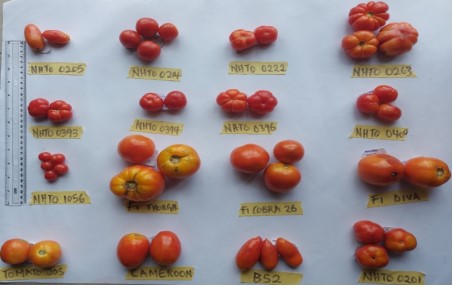Evaluation of Sixteen Tomato Genotypes (Solanum lycopersicum L.) for Yield and Associated Traits in Port Harcourt, Nigeria
| Received 30 Mar, 2025 |
Accepted 27 Jun, 2025 |
Published 30 Sep, 2025 |
Background and Objective: Tomato (Solanum lycopersicum L.) is a crop with significant nutritional and economic value, yet its productivity in Nigeria’s humid tropical region remains constrained by genotype-environment interactions. This study evaluated sixteen tomato genotypes (NHTO 0205, NHTO 0214, NHTO 0222, NHTO 0263, NHTO 0393, NHTO 0394, NHTO 0396, NHTO 0400, NHTO 1056, F1 Thorgal, F1 Cobra 26, F1 Diva, Jos, Cameroon, B52, NHTO 0201) for yield and yield-related traits to identify high-performing genotypes. Materials and Methods: Twenty seeds from each genotype were nursed for five weeks and transplanted into polythene bags (55×45 cm) at one plant per bag/replication with six replications per genotype, in a Completely Randomized Design. Data collection was on a number of fruits, number of fruits per cluster, number of fruit clusters, single fruit weight, fruit length, fruit diameter, Number of locules, Fruit set, and yield. Data were analyzed using the F-test in ANOVA and means compared using Duncan’s Multiple Range Test (p = 0.05). Results: Results showed significant differences in number of fruits, number of fruit clusters, yield, single fruit weight, fruit length, fruit diameter, and number of locules, but number of fruits per cluster and fruit set were not significantly different. Highest number of fruits (55), fruit clusters (15.8), fruits per cluster (3.3), and fruit set (54.0 %) were recorded for NHTO 0396 while NHTO 0205 produced least number of fruits (2.3) and least number of fruit clusters (1.0), tomato jos had the least number of fruits per cluster (1.7) and B52 recorded the least fruit set (21.5 %). The F1 Thorgal produced fruits with highest single fruit weight (80.5 g), highest fruit diameter (5.8 cm) and highest yield (11.9 ton/ha) while the least single fruit weight was recorded in NHTO 1056 (2.9 g), NHTO 1056 had the least fruit diameter (2.2 cm) and NHTO 0205 had the least yield (0.3 ton/ha). The highest fruit length was recorded in B52 (5.5 cm), and the highest number of locules was found in NHTO 0263 (7.1). Conclusion: This study will aid farmers and breeders in selecting high-yielding genotypes for tomato production in Port Harcourt rather than relying on other regions of the country to produce the crop. The F1 Thorgal and NHTO 0396 are recommended as potential parents for breeding programmes.
| Copyright © 2025 Goodlife et al. This is an open-access article distributed under the Creative Commons Attribution License, which permits unrestricted use, distribution, and reproduction in any medium, provided the original work is properly cited. |
INTRODUCTION
Tomato (Solanum lycopersicum L.) is one of the most important vegetable crops globally, valued for its nutritional and economic significance1. In Nigeria, tomato production plays a crucial role in food security and income generation for smallholder farmers, yet yields remain suboptimal due to factors such as poor genetic potential, environmental stress, and disease susceptibility2. Evaluating diverse tomato genotypes for yield and yield-related traits is essential for identifying high-performing varieties suited to specific agro-ecological conditions, such as Port Harcourt’s tropical climate. Such evaluations can provide valuable insights into genotype adaptability and productivity, supporting breeding programs and sustainable agricultural practices3,4. Previous studies have demonstrated significant variability among tomato genotypes in different regions, highlighting the need for localized evaluations to recommend suitable varieties5. In Port Harcourt, where high humidity and temperature fluctuations prevail, identifying genotypes with superior yield stability and stress tolerance is critical for enhancing productivity. A comprehensive assessment of sixteen tomato genotypes under these conditions will contribute to the selection of genotypes that optimize yield potential while withstanding local biotic and abiotic challenges. Despite the availability of numerous tomato genotypes in Nigeria, limited research has been conducted to evaluate their performance in the humid tropical environment of Port Harcourt. Existing studies have primarily focused on Northern or Southwestern regions, where climatic conditions differ significantly2. This study aims to bridge this gap by systematically assessing sixteen tomato genotypes for yield and yield-related traits, providing data-driven recommendations for farmers and breeders. The findings will support the development of improved tomato varieties, ultimately enhancing food security and agricultural productivity in Southern Nigeria.
MATERIALS AND METHODS
Experimental site and experimental material: The experiment was conducted between May and November, 2023 in the open field of the Botanical Garden of the Department of Plant Science and Biotechnology, Rivers State University, Port Harcourt, Rivers State, Nigeria (4.804°N, 6.980°E). The experimental site has an annual temperature range of 25-28°C, annual rainfall of 2,500 mm, and relative humidity of 80-85%. The sixteen tomato genotypes used were sourced as shown in Table 1. Twenty seeds of each tomato genotype were sown in individual perforated plastic containers (16.5×11.5×5 cm) containing sandy-loam soil for 5 weeks and seedlings transplanted into black perforated (20 holes per bag) polythene bags (55×45 cm) containing 15 kg of sandy-loam soil at the rate of one seedling per bag. Poultry manure was applied at the rate of 200 g per bag, and weeding was carried out when necessary.
Experimental design: The bags were arranged in a Completely Randomized Design (CRD) with each of the sixteen genotypes replicated six times at one seedling per bag per replication, giving a sample size of 96 plants.
| Table 1: | Sources of the sixteen tomato genotypes evaluated for yield in Port Harcourt, 2023 | |||
| Tomato genotype | Seed source |
| NHTO 0205 | Genetic Resources Unit, NIHORT, Ibadan |
| NHTO 0214 | Genetic Resources Unit, NIHORT, Ibadan |
| NHTO 0222 | Genetic Resources Unit, NIHORT, Ibadan |
| NHTO 0263 | Genetic Resources Unit, NIHORT, Ibadan |
| NHTO 0393 | Genetic Resources Unit, NIHORT, Ibadan |
| NHTO 0394 | Genetic Resources Unit, NIHORT, Ibadan |
| NHTO 0396 | Genetic Resources Unit, NIHORT, Ibadan |
| NHTO 0400 | Genetic Resources Unit, NIHORT, Ibadan |
| NHTO 1056 | Genetic Resources Unit, NIHORT, Ibadan |
| F1 Thorgal | Agriseed Ltd., Techni Sem-France |
| F1 Cobra 26 | East-West Seed International Ltd., Thailand |
| F1 Diva | Agriseed Ltd., Techni Sem-France |
| Tomato Jos | Local market |
| Cameroon | Local market |
| B52 | Genetic Resources Unit, NIHORT, Ibadan |
| NHTO 0201 | Genetic Resources Unit, NIHORT, Ibadan |
| NIHORT: National Institute of Horticultural Research and Training | |
Data collection: Data recorded followed the Distinctiveness, Uniformity and Stability (DUS) descriptors of tomato established by the International Union for the Protection of New Varieties of Plants (UPOV) as outlined by Lone et al.6:
The number of fruits per plant was determined by counting all the fruits produced by a plant.
Fruit set: Fruit set percentage was determined by dividing the number of fruits by the number of flowers, and the resulting value was multiplied by 100 %.
Fruit yield: The mean fruit weight was used to calculate yield per hectare and converted to yield in tons per hectare (tons/ha).
Fruit weight (g): The total number of mature fruits showing ripening initiation was weighed with an electronic weighing balance (Model: SF-400C3), and the fruit weight per plant was recorded. Average fruit weight was obtained by dividing fruit weight per plant by the total number of fruits per plant.
From each plant, five fruits were randomly selected to measure the fruit traits below:
| • | Fruit length (cm): Measured using Vernier Caliper (Columbus, Model-VCC) | |
| • | Fruit diameter (cm): Measured using Vernier Caliper (Columbus, Model-VCC) | |
| • | Number of locules: Fruits were cut transversely, and several locules per fruit were counted |
Statistical analysis: Data recorded were subjected to Analysis of Variance (ANOVA) in a Completely Randomized Design (CRD) as described by EL-Mansy et al.7 and tested for significance at a 5% level of significance. Treatment means were separated using Duncan’s Multiple Range Test (DMRT), where the F test was significant.
RESULTS AND DISCUSSION
Number of fruits: Data analysis showed the number of fruits per plant was significantly different among the tomato genotypes, with NHTO 0396 producing the most fruits (55) than the other genotypes followed by NHTO 1056 (33.5), NHTO 0222 (30.8), NHTO 0394 (30.2), and NHTO 0393 (26) while NHTO 0205 produced the least number of fruits (2.3) (Fig. 1 and Table 2). Kharat et al.8 also reported that genetic differences among Tomato cultivars significantly affect fruit production, with certain hybrids exhibiting higher yields due to improved stress tolerance and resource partitioning.
Number of fruit clusters: In terms of number of fruit clusters, NHTO 0396 (15.8), NHTO 0222 (12.5), NHTO 1056 (10.5), NHTO 0393 (10.3), though not significantly different from each other (p = 0.05) but were significantly different from the other genotypes except for NHTO 0394 (9.2) (Table 2). The least number of fruits per cluster was recorded in NHTO 0205 (1.0) and NHTO 0214 (1.0). The significant differences in several fruit clusters observed in this study highlight the complex interplay between genetic, environmental, and management factors influencing reproductive development. Our findings align with Ishtiaqa et al.9, who reported substantial genotypic variation in fruit cluster production among tomato cultivars.
Number of fruits per cluster: Analysis of data showed no significant difference in the number of fruits per cluster; however, the highest number of fruits per cluster was obtained from NHTO 0396 (3.3) and NHTO 0394 (3.3), while Tomato Jos had the least number of fruits per cluster (1.7).
Fruit set: Data analysis shows that there was no significant difference in the fruit set of the sixteen tomato genotypes. However, NHTO 0396 had the highest fruit set (54.0 %) while the least fruit set was recorded in B52 (21.5 %) (Table 2). The absence of significant genotypic differences in fruit set among the tomato varieties examined in this study suggests that, under the tested conditions, reproductive success may be more strongly influenced by environmental or management factors than by genetic variation. This finding contrasts with other recent studies that reported substantial genotypic variation in fruit set10,11, highlighting that such differences may only become apparent under specific stress conditions or in particular genetic backgrounds.

|
| Table 2: | Yield and fruit characteristics of sixteen tomato genotypes grown in Port Harcourt, 2023 | |||
| Tomato genotype | Number of fruits |
Number of fruit clusters |
Number of fruits per cluster |
Fruit set (%) | Yield (tons/ha) |
| NHTO 0205 | 2.3d | 1.0c | 2.3a | 22.3a | 0.3d |
| NHTO 0214 | 3.0d | 1.0c | 3.0a | 22.0a | 0.5d |
| NHTO 0222 | 30.8bc | 12.5a | 2.4a | 40.4a | 9.4ab |
| NHTO 0263 | 10.6cd | 5.2bc | 1.9a | 30.0a | 3.7bcd |
| NHTO 0393 | 26.0bc | 10.3a | 2.6a | 27.7a | 6.2abcd |
| NHTO 0394 | 30.2bc | 9.2ab | 3.3a | 39.3a | 6.0abcd |
| NHTO 0396 | 55.0a | 15.8a | 3.3a | 54.0a | 11.2a |
| NHTO 0400 | 4.0d | 2.0bc | 2.0a | 35.4a | 1.2d |
| NHTO 1056 | 33.5b | 10.5a | 3.2a | 22.1a | 1.8d |
| F1 Thorgal | 8.0cd | 3.8bc | 2.2a | 27.2a | 11.9a |
| F1 Cobra 26 | 8.5cd | 3.3bc | 2.7a | 24.3a | 5.7abcd |
| F1 Diva | 8.8cd | 4.5bc | 2.0a | 33.1a | 8.5abc |
| Tomato Jos | 5.0d | 3.0bc | 1.7a | 22.7a | 1.4d |
| Cameroon | 4.0d | 2.0bc | 2.0a | 36.5a | 2.7cd |
| B52 | 12.4bcd | 3.8bc | 3.2a | 21.5a | 4.1bcd |
| NHTO 0201 | 8.0cd | 4.0bc | 2.0a | 26.9a | 4.2bcd |
| Means in columns followed by the same letter(s) are not significantly different at a 5% level of significance according to Duncan’s Multiple Range Test | |||||
Yield (tons/ha): There were significant differences in the fruit yield of the tomato genotypes (Table 2). The highest yield was recorded in F1 Thorgal (11.9 tons/ha) followed by NHTO 0396 (11.2 tons/ha), while the lowest yield was recorded in NHTO 0205 (0.3 ton/sha) and NHTO 0214 (0.5 tons/ha).
Single fruit weight: The differences in single fruit weight for the sixteen tomato genotypes were significant (p = 0.05) as shown in Table 3. The F1 Thorgal produced fruits with the highest single fruit weight (80.5 g), followed by F1 Diva (53.8 g). These were significantly different from each other and significantly different from the other genotypes. The least single fruit weight was recorded in NHTO 1056 (2.9 g). Fruit weight is a crucial element that has a direct impact on yield. The variation in fruit weight across tomato genotypes was corroborated in previous studies12,13.
| Table 3: | Quantitative characteristics of the fruit of sixteen tomato genotypes grown in Port Harcourt, 2023 | |||
| Tomato genotype | Single fruit weight (g) | Fruit length (cm) | Fruit diameter (cm) | Number of locules |
| NHTO 0205 | 9.2de | 4.6ab | 2.6ab | 2.0b |
| NHTO 0214 | 9.0de | 2.7ab | 3.2ab | 2.5b |
| NHTO 0222 | 17.2cde | 3.2ab | 3.8ab | 2.7b |
| NHTO 0263 | 29.9cde | 3.2ab | 4.7ab | 7.1a |
| NHTO 0393 | 13.3cde | 2.6ab | 3.6ab | 2.9b |
| NHTO 0394 | 11.1cde | 2.7ab | 3.3ab | 2.9b |
| NHTO 0396 | 12.4cde | 2.8ab | 3.5ab | 2.6b |
| NHTO 0400 | 15.8cde | 3.6ab | 3.3ab | 2.0b |
| NHTO 1056 | 2.9e | 2.1b | 2.2b | 2.0b |
| F1 Thorgal | 80.5a | 5.4ab | 5.8a | 5.6a |
| F1 Cobra 26 | 37.5c | 4.6ab | 4.3ab | 3.2b |
| F1 Diva | 53.8b | 4.9ab | 5.1ab | 3.3b |
| Tomato Jos | 16.2cde | 4.7ab | 3.0ab | 3.0b |
| Cameroon | 36.1cd | 5.1ab | 4.1ab | 3.0b |
| B52 | 16.9cde | 5.5a | 2.9ab | 2.0b |
| NHTO 0201 | 28.3cde | 4.0ab | 4.5ab | 3.2b |
| Means in columns followed by the same letter(s) are not significantly different at a 5% level of significance according to Duncan’s Multiple Range Test | ||||
Fruit length and fruit diameter: The fruit length of B52 (5.5 cm) was significantly different from that of NHTO 1056 (2.1 cm) but not significantly different from the fruit length of the other tomato genotypes (Table 3). However, the highest fruit diameter was recorded in F1 Thorgal (5.8 cm), and it was significantly different from the fruit diameter of NHTO 1056 (2.2 cm) but not significantly different from the other genotypes. The significant genotypic variations observed in fruit weight, length, and diameter among the evaluated tomato genotypes highlight the strong genetic control of fruit morphology. Other researchers in their studies14,15 also demonstrated that fruit size variation in tomato is primarily governed by multiple quantitative trait loci (QTLs) affecting cell division and expansion patterns during fruit development.
Number of locules: The number of locules for genotypes NHTO 0263 (7.1) and F1 Thorgal (5.6) was significantly different from the rest of the tomato genotypes. The least number of locules (2.0) was recorded in NHTO 0205, NHTO 0400, NHTO 1056, and B52.
The present study is important for farmers to select high-yielding genotypes for tomato production in Port Harcourt rather than relying on other regions of the country to produce the crop. The study will also aid breeders to identify the best-performing tomato genotypes for breeding programmes in Port Harcourt. One limitation of the study is that it was conducted in one planting season and one location, and the tomato genotypes must be assessed in different planting seasons and multiple locations. The F1 Thorgal and NHTO 0396 tomato genotypes are recommended as potential parents for breeding programs.
CONCLUSION
The evaluation of sixteen tomato genotypes under the agro-ecological conditions of Port Harcourt revealed significant variations in yield and yield-related traits, highlighting the importance of genotype selection for optimal productivity. Among the tested genotypes, NHTO 0396 and F1 Thorgal demonstrated superior performance in terms of fruit number, average fruit weight, and total yield per plant, suggesting their potential for cultivation in humid tropical environments and suitability for further breeding programs or direct adoption by local farmers.
SIGNIFICANCE STATEMENT
This study discovered the high-yielding and adaptable tomato genotypes that can be beneficial for improving tomato productivity, profitability, and food security in the humid tropical environment of Port Harcourt. The evaluation of sixteen tomato genotypes under local agro-climatic conditions provided valuable insights into genotype performance and trait stability. These findings will aid farmers in selecting superior varieties while offering breeders a genetic resource base for developing resilient cultivars. Moreover, this study will help the researchers to uncover the critical areas of genotype-environment interaction and trait heritability that many researchers were not able to explore. Thus, a new theory on genotype adaptability and trait-based selection in tropical tomato cultivation may be arrived at.
ACKNOWLEDGMENT
The seeds of eleven of the sixteen tomato genotypes used in the study were obtained from the National Institute of Horticultural Research and Training (NIHORT), Ibadan, Nigeria.
REFERENCES
- FAOUN, 2021. The State of Food and Agriculture 2021: Making Agrifood Systems More Resilient to Shocks and Stresses. Food & Agriculture Organization, Rome, Italy, ISBN: 9789251343296, Pages: 182.
- Ajenifujah-Solebo, S.O., P.E. Akin-Idowu, A.O. Aduloju, V.O. Adedeji and E.T. Akinyode et al., 2025. Tomato Crop Improvement Efforts in Nigeria: Past, Current and Future Perspectives. In: Solanum lycopersicum L.-Research Methods, Approaches, and Perspectives, Rekoslavskaya, N., IntechOpen, London, United Kingdom.
- Goodlife, E.E., E.T. Jaja and V. Wilson, 2023. Yield performance and fruit characteristics of tomato (Solanum lycopersicum L.) genotypes in a high rainfall region. Int. Res. J. Biol. Sci., 12: 17-28.
- Khan, M. and A.P. Garg, 2024. Phenotypic trait analysis of tomato (Solanum lysopersicum) genotypes in Qatar and Indian agro-climatic conditions. Indian J. Agric. Res., 58: 969-978.
- Tripodi, P., S. Soler, G. Campanelli, M.R. Figàs and C. Casanova et al., 2025. GGE analysis and stability of traits in tomato cultivars grown under organic farming conditions: A two-year study. Hortic. Plant J., 11: 721-736.
- Lone, S., K. Hussain, K.Z. Masoodi, S. Narayan, S.M. Hussain, M. Rashid and H. Kumar, 2021. Distinctness, uniformity and stability testing of various cherry tomato accessions. J. Pharmacogn. Phytochem., 10: 2776-2788.
- EL-Mansy, A., D.A. El-Moneim, S. ALshamrani, F. Safhi, M. Abdein and A. Ibrahim, 2021. Genetic diversity analysis of tomato (Solanum lycopersicum L.) with morphological, cytological, and molecular markers under heat stress. Horticulturae, 7.
- Kharat, K.P., A.V. Chandanshive, S.D. Gaikwad, B.B. Handal, B.T. Patil and S.A. Ranpise, 2022. Evaluation of tomato (Solanum lycopersicum L.) genotypes for qualitative and quantitative characteristics. J. Agric. Res. Technol., 47: 281-289.
- Ishtiaqa, H., T. Ahmada, S.A.M. Bokharia, M.A.B. Saddiqueb and S.F. Usmanib et al., 2024. Genetic variability in high yielding tomato (Solanum lycopersicum) lines. J. Food Agric. Technol. Res., 3: 57-65.
- Rasheed, A., M. Ilyas, T.N. Khan, A. Mahmood and U. Riaz et al., 2023. Study of genetic variability, heritability, and genetic advance for yield-related traits in tomato (Solanum lycopersicon MILL.). Front. Genet., 13.
- Hasan, M.M., M.A. Al Bari and M.A. Hossain, 2016. Genetic variability and traits association analysis of tomato (Lycopersicon esculentum L.) genotypes for yield and quality attributes. Univers. J. Plant Sci., 4: 23-34.
- Zannat, A., M.A. Hussain, A.H.M. Abdullah, M.I. Hossain and M. Saifullah et al., 2023. Exploring genotypic variability and interrelationships among growth, yield, and quality characteristics in diverse tomato genotypes. Heliyon, 9.
- Sarker, A., M.S. Masuda, Z. Mushrat, M. Ashrafuzzaman, M.K. Khan and M. Arifuzzaman, 2025. Selection of superior genotypes using morpho-biochemical traits and crossability among them in cherry tomato (Solanum lycopersicum var. cerasiforme). Discover Plants, 2.
- Jogi, M., V. Naik, R.K. Ramachandra, H.B. Lingaiah, K.M. Indiresh, D.K. Samuel and T.H. Singh, 2023. Performance of tomato genotypes for growth and yield under Eastern Dry Zone of Karnataka, India. Int. J. Environ. Clim. Change, 13: 1821-1839.
- Adhikari, P., J. McNellie and D.R. Panthee, 2020. Detection of quantitative trait loci (QTL) associated with the fruit morphology of tomato. Genes, 11.
How to Cite this paper?
APA-7 Style
Goodlife,
E.E., Jaja,
E.T., Wilson,
V., Adeleke,
M.T. (2025). Evaluation of Sixteen Tomato Genotypes (Solanum lycopersicum L.) for Yield and Associated Traits in Port Harcourt, Nigeria. Trends in Agricultural Sciences, 4(3), 176-182. https://doi.org/10.17311/tas.2025.176.182
ACS Style
Goodlife,
E.E.; Jaja,
E.T.; Wilson,
V.; Adeleke,
M.T. Evaluation of Sixteen Tomato Genotypes (Solanum lycopersicum L.) for Yield and Associated Traits in Port Harcourt, Nigeria. Trends Agric. Sci 2025, 4, 176-182. https://doi.org/10.17311/tas.2025.176.182
AMA Style
Goodlife
EE, Jaja
ET, Wilson
V, Adeleke
MT. Evaluation of Sixteen Tomato Genotypes (Solanum lycopersicum L.) for Yield and Associated Traits in Port Harcourt, Nigeria. Trends in Agricultural Sciences. 2025; 4(3): 176-182. https://doi.org/10.17311/tas.2025.176.182
Chicago/Turabian Style
Goodlife, Eugenia, E., Emylia T. Jaja, Victoria Wilson, and Martina T.V. Adeleke.
2025. "Evaluation of Sixteen Tomato Genotypes (Solanum lycopersicum L.) for Yield and Associated Traits in Port Harcourt, Nigeria" Trends in Agricultural Sciences 4, no. 3: 176-182. https://doi.org/10.17311/tas.2025.176.182

This work is licensed under a Creative Commons Attribution 4.0 International License.




